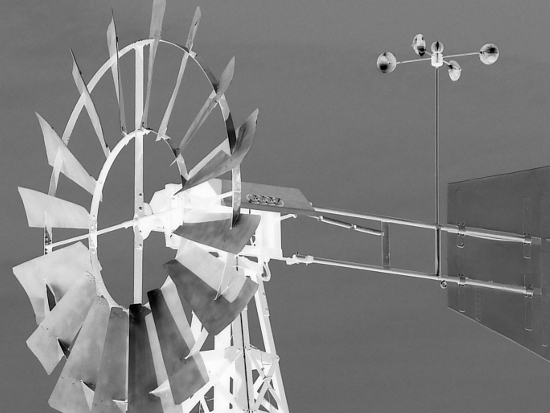project at www.under-construction.cc
| A |
AnemometerGeneral Concept The term "anemometer" has its origins in Greek, from "anemos" (the wind) and "metron" (measure).
The earliest technical description of an anemometer in European history is to be found around 1450 in Leon Battista Alberti's writings. The related illustration sports a wind vane made of three parallel arrow rods ("gangheretti o arpioncini"), attached to it what later would have been called a small wind plate anemometer (Windplatte): A vertical quadrant arc mounted on one of the wind vane's rods combined with a mobile element that is moved by the wind ("uno arco qui penda allo ingiu attacato in modo, que quando questa assicella andra o piu alto o piu basso secondo che sara spinta della qualità dell'uento […]"). Around 1500 Leonardo da Vinci developed on this basis his own version of a plate-pendulum anemometer, sketched out in his Codex Atlanticus (fol. 249v). Here we find the vertical quadrant arc mounted on a base, with the mobile plate hanging from a horizontal board arranged in right angle to th quadrant arc. Leonardo also notes that the arc should be marked with the minutes and seconds, so the scale would allow to measure the wind's force. Moreover, he also designed another, slightly different and refined version (Codex Atlanticus, fol. 675) for which he set up the hanging construction in the opposite direction (for a better use of the scale) and combines it with a wind vane (not to better catch the wind, but simply to show the wind's direction). Leonardo's anemometer is worth to mention here for several reasons. Not only his sketches are published widely and therefore his model is probably the most prominent historical source researchers as well as nowadays wind clock builders refer to. His sketches were also one of the sources of inspiration for the TIK Wind Clocks (or, to be more precise: one of the TIK Windclock interfaces). Note: This entry will be continued (and hopefully also illustrated sooner or later as well, including notes and references related to contemporary anemometers). Also more links and resources will be added. … Related entries: External Hyperlinks: Museo Nazionale della ]]Scienza e della Tecnologia Leonardo Da Vinci[[, Milan ]]Historical Windclocks[[ – ]]www.geag.de[[ Pls. note this page contains hyperlinks to external websites. These should open in a separate window of your browser. Moreover, you might like to consult the [disclaimer]. |


